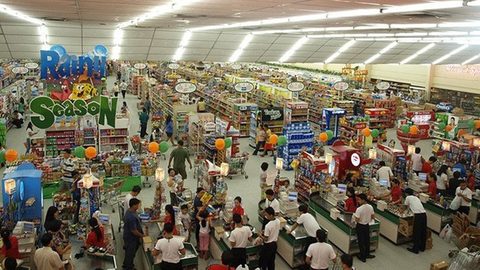VN’s retail sales to touch over $1.9 trillion
VN’s retail sales to touch over $1.9 trillion
The revenue of Viet Nam’s retail sales market will reach over VND11 quadrillion (US$484.58 billion) by 2025 and nearly VND44 quadrillion ($1.938 trillion) by 2035.

This was revealed in the Ministry of Industry and Trade’s draft strategy on domestic trade development, which is being publicised for recommendations.
According to the draft, the GDP of the domestic trade sector will be more than VND419 trillion by 2020, VND700 trillion by 2025, and VND2.3 quadrillion by 2035, contributing roughly 15.5-16 per cent to Viet Nam’s GDP by 2030.
The annual growth rate (excluding the price factor) of the country’s total revenue from retail sales of goods and services for the period from now to 2020 will average at 13 per cent per year, and rise to 14 per cent in 2021-25. The value will reach some VND5.8 quadrillion by 2020, VND11 quadrillion by 2025 and VND44 quadrillion by 2035.
Domestic economic sector will account for some 80 per cent of the country’s total retail sales revenue by 2020, while the foreign direct investment (FDI) sector will make up about 20 per cent before rising to 70 per cent by 2025.
The proportion of modern trade models will be roughly 30 per cent, or nearly VND1.7 quadrillion, by 2020. It will rise to 35 per cent or VND3.8 quadrillion by 2025 and 50 percent or VND22 quadrillion by 2035.
Modern trade models such as commodity exchanges, auction centres and franchises will be also developed, and e-commerce will be boosted to have more than 60 per cent of small- and medium-d enterprises (SMEs) participating in e-commerce by 2020 and 80-90 percent by 2035.
For the period after 2025, the GDP of the domestic trade sector will reach some VND2.3 quadrillion by 2035, contributing some 15.5-16 percent to Viet Nam’s GDP by 2030.
The annual growth rate of total retail sales of goods and services will average at 14.5 percent per year in the period and reach over VND11 trillion by 2025 and VND44 quadrillion by 2035.
The trade system in the country’s urban areas will be streamlined to meet the standards of ASEAN 4 by 2035.
According to the Ministry of Industry and Trade, the strategy was drafted based on data during the period from 2011 to 2015 when the GDP growth rate of the domestic trade sector was 9.05 per cent per year. Besides, the ministry also based its strategy on the evaluation and forecast of commercial trends in the domestic and global markets.
Viet Nam last year was ranked by A.T. Kearney among the world’s top 30 retail markets with the best opportunities. The country’s retail market last year rose 10.2 per cent over the previous year to VND3.5 quadrillion, according to the General Statistics Office.
The market has been an attractive destination for foreign investors thanks to its relatively young population, a rapidly expanding middle class and high living standards.
Almost 60 per cent of Viet Nam’s population of roughly 93 million people is under the age of 35, and is becoming better educated and richer. The country’s average income last year jumped to $2,200 from a meager $433 in 2000, according to official data.
The World Bank forecast that Viet Nam’s $200 billion economy is likely to grow to a trillion dollars by 2035, with more than half of its population, compared to only 11 per cent today, expected to join the ranks of the global middle class with the consumption of $15 a day or more.





















